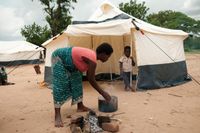
Photo credits: UNICEF/NYHQ2015-0097/van de M
Ongoing monitoring of MNHabbreviation services is essential to understand the needs of women and newborns in the acute emergency phase, and whether their needs are being met as response activities progress to providing comprehensive MNHabbreviation services. It is therefore important to work with the SRHabbreviation coordinator to identify a partner with expertise in M&Eabbreviation. The SRHabbreviation coordinator should task that partner with developing an overall M&Eabbreviation plan for the delivery of MNHabbreviation services throughout the affected area that utilizes standardized methods of data collection, reporting for assessments and ongoing monitoring.
Tracking program progress and outcomes requires data from a variety of sources, including pre-crisis mortality and morbidity statistics, facility related data, and process and outcomes data related to health program implementation.
Use standardized indicators to collect population-level data to the extent possible; Annex 6 presents a list of health indicators, how to calculate them, and how to use them in program M&Eabbreviation. The indicators are organized into the following domains:
- Outcomes
- Service utilization, coverage and quality of care
- Service availability
- Service readiness
- Equipment and supplies
- Training
- Supervision
- Mortality surveillance and response
These indicators are based on demographic data typically collected through national and sub-national data systems that are routinely aggregated from agency/field level up to the national level, and published in governmental reports. Collection of key programmatic indicators may also be useful for fundraising purposes.
- Use indicators to inform health managers at the local, regional and national levels about the extent of MNHabbreviation service coverage and the quality of services being provided.
- Require program managers to review and apply the information to identify gaps in service provision and define necessary program modifications.
- If managers do not possess adequate data analysis skills to carry out data review, consult the agency designated as the monitoring and evaluation lead for the SRHabbreviation working group for help with staff training support or tools, as needed.
Box 4.6: Good practice: Za’atari Camp, Jordan
The Health Information System in Za’atari, a large refugee camp in Jordan, detected an increase in neonatal death. In response, UNHCR established a neonatal death audit process that helped expose two key contributors to the rise in newborn mortality: poor provider knowledge of danger signs and a weak referral system.
UNHCR. Operational guidelines on improving newborn health in refugee operations. UNHCR. 2014, p. 5
4.4.1 Compromised data flow and routine information systems
During a crisis, routine information systems and data flow may be compromised. In such cases:
- Develop a reduced set of critical core indicators to aggregate and channel upwards from the agency or community level to regional or national program managers.
- Continue to capture additional indicators at lower levels to allow for quality assurance and service improvement
- Aggregate agency-level data in an overall M&Eabbreviation system, if possible.
For routine program monitoring, the number of newborn deaths, stillbirths, and babies born with low birthweight should be tracked, as well as the number of newborns breastfed within 1 hour of birth and receiving Hepatitis B immunization prior to discharge. Case fatality rate alone is insufficient to assess program quality (See Annex 6 for a list of suggested indicators). Further guidance on monitoring and evaluation can also be found in Chapter 9.6 of The Inter-Agency Field Manual on Reproductive Health in Humanitarian Settings.

